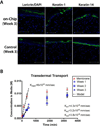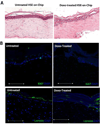Pumpless microfluidic platform for drug testing on human skin equivalents
- PMID: 25490891
- PMCID: PMC4305008
- DOI: 10.1039/c4lc00999a
Pumpless microfluidic platform for drug testing on human skin equivalents
Abstract
Advances in bio-mimetic in vitro human skin models increase the efficiency of drug screening studies. In this study, we designed and developed a microfluidic platform that allows for long-term maintenance of full thickness human skin equivalents (HSE) which are comprised of both the epidermal and dermal compartments. The design is based on the physiologically relevant blood residence times in human skin tissue and allows for the establishment of an air-epidermal interface which is crucial for maturation and terminal differentiation of HSEs. The small scale of the design reduces the amount of culture medium and the number of cells required by 36 fold compared to conventional transwell cultures. Our HSE-on-a-chip platform has the capability to recirculate the medium at desired flow rates without the need for pump or external tube connections. We demonstrate that the platform can be used to maintain HSEs for three weeks with proliferating keratinocytes similar to conventional HSE cultures. Immunohistochemistry analyses show that the differentiation and localization of keratinocytes was successfully achieved, establishing all sub-layers of the epidermis after one week. Basal keratinocytes located at the epidermal-dermal interface remain in a proliferative state for three weeks. We use a transdermal transport model to show that the skin barrier function is maintained for three weeks. We also validate the capability of the HSE-on-a-chip platform to be used for drug testing purposes by examining the toxic effects of doxorubucin on skin cells and structure. Overall, the HSE-on-a-chip is a user-friendly and cost-effective in vitro platform for drug testing of candidate molecules for skin disorders.
Figures




References
-
- Abaci HE, Drazer G, Gerecht S. Nano LIFE. 2013 03.
-
- Wagner I, Materne EM, Brincker S, Sussbier U, Fradrich C, Busek M, Sonntag F, Sakharov DA, Trushkin EV, Tonevitsky AG, Lauster R, Marx U. Lab Chip. 2013;13:3538–3547. - PubMed
Publication types
MeSH terms
Substances
Grants and funding
LinkOut - more resources
Full Text Sources
Other Literature Sources

